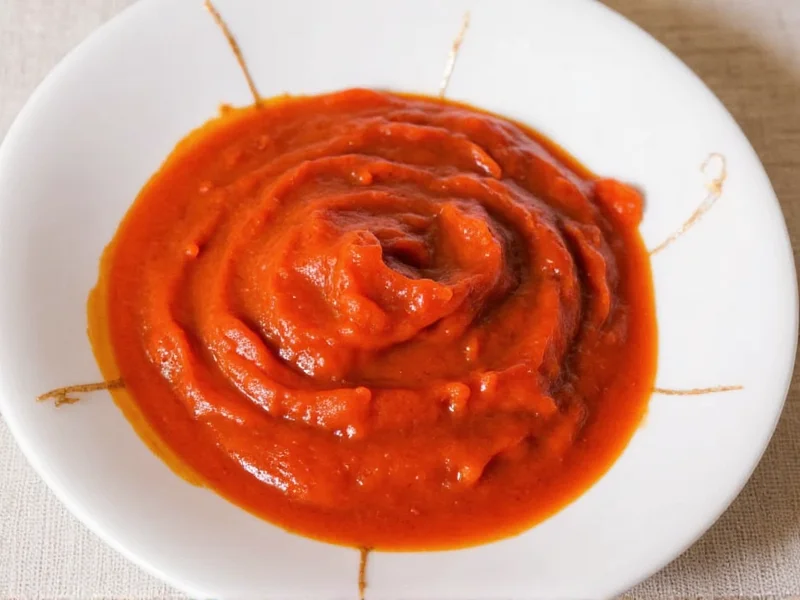Gochujang, Korea's beloved fermented chili paste, creates a distinctive taste experience that defines much of Korean cuisine. Understanding what does gochujang paste taste like requires examining its multifaceted flavor components that work in harmony rather than competing elements.
The Complete Flavor Profile of Gochujang
Unlike one-dimensional hot sauces, authentic gochujang presents a sophisticated balance that evolves on your palate. When you first taste gochujang, you'll notice the immediate but moderate heat from Korean red pepper flakes (gochugaru), which registers around 3-5 on a 10-point heat scale. This warmth never becomes painfully spicy but instead serves as a foundation for the other flavors.
The sweetness in gochujang comes from its traditional fermentation process involving glutinous rice and meju (fermented soybean blocks). This isn't sugary sweetness but rather a deep, caramelized complexity developed over months of fermentation. The resulting flavor profile of gochujang paste contains rich umami notes comparable to aged cheeses or soy sauce, but with distinctive Korean characteristics.
| Flavor Component | Intensity Level | Comparable Taste Reference |
|---|---|---|
| Spiciness | Moderate (3-5/10) | Milder than cayenne, hotter than paprika |
| Sweetness | Medium | Similar to miso with caramel notes |
| Umami | High | Deeper than soy sauce, comparable to aged tomato paste |
| Tanginess | Low-Medium | Subtle vinegar-like note from fermentation |
| Aftertaste | Persistent | Warm, savory finish with lingering sweetness |
How Gochujang Differs From Similar Condiments
Many people wonder what does gochujang paste taste like compared to sriracha or other popular sauces. While both are chili-based, gochujang offers a completely different experience:
- Sriracha delivers immediate, sharp heat with vinegar tang and garlic notes, while gochujang provides layered complexity with fermented depth
- Harissa features roasted pepper and spice blend flavors, whereas gochujang showcases fermented soybean and rice characteristics
- Chipotle paste offers smoky heat, while gochujang presents earthy, fermented warmth without smoke
- Ketchup is primarily sweet-tomato with vinegar, while gochujang's sweetness comes from fermentation with significant umami
When exploring what does gochujang paste taste like in Korean cooking, you'll discover how its flavor transforms when heated. Cooking gochujang deepens its sweetness and mellow's its heat while enhancing the umami characteristics. This transformation explains why it works so well in stews like budae jjigae and marinades for dishes like tteokbokki.
Texture and Appearance Factors
Gochujang's thick, almost paste-like consistency significantly impacts the tasting experience. Unlike liquid hot sauces, it has a slightly sticky texture that clings to food and coats the tongue. The color ranges from deep crimson to dark brick red, indicating the quality and maturity of the fermentation process.
High-quality gochujang should spread smoothly without being runny or overly stiff. When you open a container, you'll notice a pleasant fermented aroma—earthy and slightly sweet rather than vinegary or artificial. This authentic gochujang flavor profile explained helps distinguish traditional varieties from mass-produced imitations.
Practical Tasting Tips for First-Time Users
If you're experiencing gochujang for the first time, consider these recommendations:
- Start with small amounts—a 1:4 ratio with other ingredients lets you appreciate its complexity without overwhelming your dish
- Pair with neutral bases like rice, tofu, or potatoes to fully experience how to describe gochujang taste characteristics
- Combine with complementary flavors: sesame oil enhances its nuttiness, while rice vinegar balances its richness
- Allow cooked dishes containing gochujang to rest for 15-20 minutes before serving—this lets the flavors fully integrate
Understanding what ingredients make up gochujang flavor helps appreciate its complexity. Traditional gochujang contains only four core ingredients: glutinous rice, Korean red pepper flakes, fermented soybeans (meju), and salt. The magic happens during the months-long fermentation process where enzymes break down starches into sugars and proteins into amino acids, creating that signature sweet-umami balance.
Storage and Flavor Preservation
Proper storage maintains gochujang's delicate flavor balance. Keep opened containers refrigerated in airtight containers, where it will maintain peak flavor for 6-12 months. Exposure to air causes oxidation that diminishes the vibrant red color and subtle sweet notes. High-quality gochujang develops more complex flavors over time when properly stored, similar to aged wines or cheeses.
Common Questions About Gochujang's Taste
Many home cooks wonder is gochujang paste spicy or sweet—the answer is both, but neither dominates. The heat registers as moderate warmth rather than intense burn, while the sweetness emerges as the sauce lingers on your palate. This balance explains why Koreans describe gochujang's flavor as "matteum" (sweet) rather than "maesot" (sugary sweet).
When considering gochujang aftertaste characteristics, note that quality gochujang leaves a pleasant, savory finish rather than harsh burning or artificial aftertaste. Inferior versions may have vinegar sharpness or chemical notes from preservatives, but authentic gochujang's aftertaste should be warm and inviting, encouraging another bite.











 浙公网安备
33010002000092号
浙公网安备
33010002000092号 浙B2-20120091-4
浙B2-20120091-4